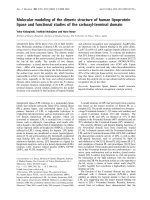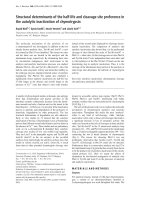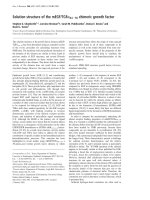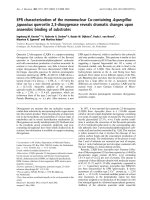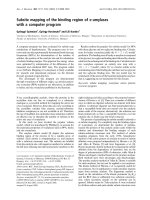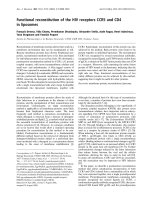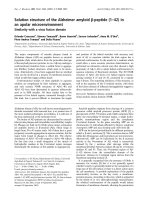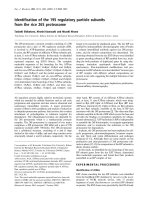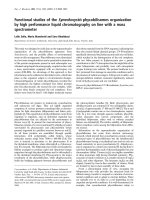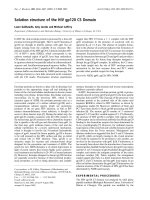Báo cáo Y học: Trehalose-phosphate synthase of Mycobacterium tuberculosis Cloning, expression and properties of the recombinant enzyme pdf
Bạn đang xem bản rút gọn của tài liệu. Xem và tải ngay bản đầy đủ của tài liệu tại đây (436.18 KB, 10 trang )
Trehalose-phosphate synthase of
Mycobacterium tuberculosis
Cloning, expression and properties of the recombinant enzyme
Y. T. Pan
1
, J. D. Carroll
2
and A. D. Elbein
1
1
Department of Biochemistry and Molecular Biology and
2
Department of Microbiology and Immunology, University of Arkansas
for Medical Sciences, Little Rock, Arkansas, USA
The trehalose-phosphate synthase (TPS) of Mycobacterium
smegmatis was previously purified to apparent homogeneity
and several peptides from the 58 kDa protein were
sequenced. Based on that sequence information, the gene for
TPSwasidentifiedintheMycobacterium tuberculosis
genome, and the gene was cloned and expressed in Escheri-
chia coli with a (His)
6
tag at the amino terminus. The TPS
was expressed in good yield and as active enzyme, and was
purified on a metal ion column to give a single band of
58 kDa on SDS/PAGE. Approximately 1.3 mg of puri-
fied TPS were obtained from a 1-L culture of E.coli( 2.3 g
cell paste). The purified recombinant enzyme showed a single
band of 58 kDa on SDS/PAGE, but a molecular mass of
220 kDa by gel filtration, indicating that the active TPS is
probably a tetrameric protein. Like the enzyme originally
purified from M. smegmatis, the recombinant enzyme is an
unusual glycosyltransferase as it can utilize any of the
nucleoside diphosphate glucose derivatives as glucosyl
donors, i.e. ADP–glucose, CDP–glucose, GDP–glucose,
TDP–glucose and UDP–glucose, with ADP–glucose, GDP–
glucose and UDP–glucose being the preferred substrates.
These studies prove conclusively that the mycobacterial TPS
is indeed responsible for catalyzing the synthesis of trehalose-
P from any of the nucleoside diphosphate glucose deriva-
tives. Although the original enzyme from M. smegmatis was
greatly stimulated in its utilization of UDP–glucose by
polyanions such as heparin, the recombinant enzyme was
stimulated only modestly by heparin. The K
m
for UDP–
glucose as the glucosyl donor was 18 m
M
,andthatfor
GDP–glucose was 16 m
M
. The enzyme was specific for
glucose-6-P as the glucosyl acceptor, and the K
m
for this
substrate was 7m
M
when UDP–glucose was the glucosyl
donor and 4m
M
with GDP–glucose. TPS did not show an
absolute requirement for divalent cations, but activity was
increased about twofold by 10 m
M
Mn
2+
. This recombinant
system will be useful for obtaining sufficient amounts of
protein for structural studies. TPS should be a valuable
target site for chemotherapeutic intervention in tuberculosis.
Trehalose is a nonreducing disaccharide in which the two
glucoses are linked in an a,a-1,1-glycosidic linkage [1]. This
naturally occurring anomer of trehalose is widespread in
nature, being found in bacteria, fungi, yeast, plants, insects
and lower animals [2]. In many organisms, trehalose
synthesis is induced in response to a small set of specific
environmental conditions. In particular, trehalose is accu-
mulated during periods of nutrient starvation, desiccation,
and after exposure to mild heat shock [3,4]. Thus, it has been
proposed that this sugar serves as a stabilizer of cellular
structures under stress conditions [5]. In agreement with this
hypothesis, in vitro studies have shown that trehalose has an
exceptional capacity for protecting biological membranes
and enzymes from the adverse effects of freezing, or drying-
induced dehydration [6], as well as from stress induced by
exposure to oxygen radicals [7]. Trehalose may also aid in
protein folding [8].
This disaccharide may also play other roles in various
cells. For example, in Streptomyces hygroscopicus, very little
trehalose is found in the vegetative mycelia, but trehalose is
abundant in the spores [9]. Thus, in this organism and other
bacteria and fungi, as well as in various insects, trehalose
probably functions as a storehouse of glucose and energy,
such as for flight muscle contraction, and for spore
germination [10]. On the other hand, trehalose appears to
be constitutively present in mycobacteria, as it is present in
the cytosol at levels of 1–3% of the dry weight of these cells
under normal growth conditions [11]. Although the function
of this cytosolic trehalose is not known, the trehalose pool in
growing and well-fed cells of Mycobacterium smegmatis is
subject to rapid turnover, suggesting that the free trehalose
pool is not accumulated just for storage of glucose [12].
Furthermore, trehalose is an integral component of a
number of different glycolipids in mycobacteria, and these
compounds appear to be essential cell wall structures [13]. In
fact, one of the toxic components of the cell wall of
Mycobacterium tuberculosis is called cord factor and has the
structure, trehalose-6,6¢-dimycolate [14].
The transfer of glucose from UDP–glucose to glucose-
6-phosphate to form trehalose-6-phosphate was first
demonstrated using cell-free extracts of Saccharomyces
cerevesiae [15]. This reaction was also demonstrated in
locusts [16], in silk moths [17], in M. tuberculosis [18] and in
Dictyostelium discoideum [19]. The enzyme catalyzing this
reaction, i.e. the trehalose-phosphate synthase (TPS), was
Correspondence to: A. D. Elbein, Department of Biochemistry and
Molecular Biology, University of Arkansas for Medical Sciences,
Little Rock, Arkansas, 72205, USA.
Fax: + 1 501 686 8169, Tel.: + 1 501 686 5176,
E-mail:
Abbreviations: IPTG, isopropyl thio-b-
D
-galactoside; TPS, trehalose-
phosphate synthase.
(Received 24 May 2002, revised 6 September 2002,
accepted 21 October 2002)
Eur. J. Biochem. 269, 6091–6100 (2002) Ó FEBS 2002 doi:10.1046/j.1432-1033.2002.03327.x
purified to near homogeneity from cytosolic extracts of
M. smegmatis [20], and that enzyme preparation could use
any of the glucose sugar nucleotides (i.e. ADP–glucose,
CDP–glucose, GDP–glucose, TDP–glucose and UDP–
glucose) as glucosyl donors to form trehalose-6-P [21].
However, there was a difference in the rate of trehalose-P
formation with the different glucosyl donors, with ADP–
glucose, GDP–glucose and UDP–glucose being best [21].
The substrate specificities, or the other enzymatic properties,
of TPSs from these other organisms have not been reported.
The gene for the trehalose-P synthase (otsA)wasiden-
tified in Escherichia coli [22] and has been expressed in
various organisms [23,24]. Neither this enzyme, nor the
yeast enzyme, have been expressed or isolated in sufficient
amounts to determine the substrate specificity with regard
to the glucosyl donor, or other properties of these TPSs. The
enzyme from M. smegmatis was purified to apparent
homogeneity and several peptides from this protein were
sequenced [20]. Based on the amino acid sequences of these
peptides, the putative TPS gene from M. tuberculosis was
identified. In this report, we describe the cloning and
expression of the M. tuberculosis tps gene in E.coli,andthe
production of active TPS in these cells. The properties of the
recombinant enzyme have been determined, and are com-
pared to the properties of the TPS purified from M. smeg-
matis. This expression system should provide sufficient
amounts of recombinant TPS for complete structural
characterization of this enzyme. Furthermore, trehalose is
not found in any mammalian cells but it appears to play an
important role as a structural component of the M. tuber-
culosis cell wall, and might also function as a stabilizer and
protector of membranes and proteins when this organism
undergoes latency. Therefore, enzymes involved in the
biosynthesis of trehalose may represent excellent target sites
for new chemotherapeutic drugs against tuberculosis and
other mycobacterial diseases.
EXPERIMENTAL PROCEDURES
Bacterial strains and culture conditions
M. smegmatis was obtained from the American Type Cul-
ture Collection (ATCC 14468). The E.colistrains DH5a
and HMS-F [25] were used for cloning and expression
studies, respectively. HMS-F is a derivative of the expres-
sion strain HMS174(DE-3) (Novagen). HMS174(DE-3)
contains a chromosomal isopropyl thio-b-
D
-galactoside
(IPTG)-inducible T7 RNA pol gene. HMS-F contains an
additional copy of the lac repressor lacI
q
on an F episome,
which was transferred from the E.colicloning strain XL-1
(Stratagene). This addition effectively represses expression
from the T7 promoter on the E.coli expression vector
pET15b (Novagen) in the absence of IPTG. HMS-F was
routinely cultured in the presence of 10 lgÆmL
)1
tetracycline
to maintain carriage of the F episome. E.coli strains
were cultured in L-broth and on L-agar supplemented
with 100 lgÆmL
)1
ampicillin, 20 lgÆmL
)1
kanamycin or
10 lgÆmL
)1
tetracycline, individually or in combination
where applicable. M. tuberculosis H37Rv was cultured in
Middlebrook 7H9 broth and on Middlebrook 7H10 agar,
supplemented in each case with 10% (v/v) oleic acid-
albumin-dextrose complex. All bacterial strains were cul-
tured at 37 °C.
Materials
Nucleoside diphosphate sugars, nucleoside mono-, di- and
triphosphates, alkaline phosphatase, heparin and anthrone
were from Sigma Chemical Co. Trypticase Soy broth was
from Becton Dickinson Co. Electrochemiluminescence
Western blotting detection reagents were from Amersham
Pharmacia Biotech Inc. Ni–NTA HisÆbinding resin was
obtained from Novagen, and used according to the
manufacturer’s recommendations. LB broth was from
Fisher Scientific Co. Except where otherwise specified, all
DNA manipulation enzymes, including restriction endo-
nucleases, polymerases and ligase, were supplied by New
England Biolabs, and used according to the manufacturer’s
instructions. Custom oligonucleotide primers were com-
mercially synthesized by Integrated DNA Technologies
(Coralville, IA, USA). All other chemicals were from
reliable chemical suppliers and were of the best grade
available.
Western immunobloting
E.colistrains containing recombinant pET15b or p996A458
were cultured for 2–4 h in L broth containing ampicillin,
tetracycline and 0.1 or 1 m
M
IPTG. The bacterial cells were
harvested by centrifugation and the pellets were suspended
in 200 lL of protein final sample buffer [PFSB: 125 m
M
Tris/HCl, pH 6.8, 10% (v/v) glycerol, 10% (v/v) b-merca-
ptoethanol, 10% (w/v) SDS, 0.25% (w/v) Bromophenol
blue]. The suspensions were boiled for 10 min and centri-
fuged briefly to remove any insoluble material. The
supernatant liquid was subjected to PAGE and proteins
were transferred to nitrocellulose as described previously
[26]. Proteins with (His)
6
tags were detected with mouse
anti(His)
6
-IgG (Amersham) and goat anti-mouse alkaline
phosphatase conjugate (GAM-AP, Biorad Inc.), and visu-
alized with commercially available colorimetric substrates
(Immun-Blot, Biorad).
Rabbit antibody prepared against the purified M. smeg-
matis TPS was also used in Western blots. This antibody
was shown to cross-react with the recombinant M. tuber-
culosis TPS [20,21]. In this case, the antibody reactive bands
were detected by the electrochemiluminescence Western
blotting detection reagents according to the manufacturer’s
protocol. Proteins were also detected by staining with
Coomassie blue.
Assay of TPS activity
Formation of trehalose-P could be assayed by a colorimetric
method which involved destroying all reducing sugars by
treatment with alkali and then detection of trehalose by the
anthrone method. This assay was useful for both crude
extracts and for more purified enzyme preparations.
Trehalose formation could also be assayed spectrophoto-
metrically in an enzyme coupled assay where the UDP,
released when glucose was transferred from UDP–glucose
to glucose-6-P, was detected and quantified by coupling the
conversion of phosphoenolpyruvate to pyruvate by pyru-
vate kinase, and the conversion of pyruvate to lactate by
lactate dehydrogenase. In this final reaction, the oxidation
of NADH, i.e. the formation of NAD
+
, was measured at
340 nm. This spectrophotometric assay worked well with
6092 Y. T. Pan et al. (Eur. J. Biochem. 269) Ó FEBS 2002
the purified TPS and in fact gave identical results to the
colorimetric assay (see Fig. 5), but it was not reliable with
crude extracts or with partially purified preparations. It was
also not reliable when GDP–glucose was used as the
glucosyl donor.
Incubation mixtures for measuring TPS activity by the
colorimetric assay contained the following components in a
final volume of 0.1 mL: nucleoside diphosphate glucose,
1 lmol; glucose-6-P, 1 lmol; MnCl
2
,1lmol; Tris/HCl
pH 8.0, 5 lmol, and an appropriate amount of enzyme.
Assays were carried out in the absence or presence of 1 lg
heparin per incubation mixture. Incubations were usually
for 15–30 min at 37 °C, but other times were used as
indicated in the text. Trehalose-6-P formation was deter-
mined by a colorimetric assay as reported previously [20,21].
This procedure is briefly described here. At the end of the
incubation, HCl was added to a final concentration of
0.1
M
, and the reactions were heated for 10 min at 100 °Cto
destroy any remaining sugar nucleotide. Then, NaOH was
added to a final concentration of 0.15
M
,andsamples
were again heated at 100 °C to destroy all reducing sugars.
Trehalose is a nonreducing sugar and is stable to both the
mild acid treatment and the alkaline treatment. It could then
be determined and quantitated by the anthrone colorimetric
method for hexoses.
For assaying trehalose-P formation by the spectro-
photometric method, assay mixtures contained the same
components as in the colorimetric method, i.e. 1 lmol each
of glucose-6-P, UDP–glucose and MgCl
2
in 100 lL50m
M
Tris/HCl, pH 8.0. The reactions were stopped by heating
and the following components were added: 0.15 m
M
NADH, 0.25 m
M
phosphoenolpyruvate, 5 m
M
MgCl
2
,
and 2 lg each of pyruvate kinase and lactate dehydrogenase
in a final volume of 200 lL50m
M
Hepes buffer, pH 7.0.
The rate of NADH oxidation was measured at A
340
as
showninFig.5.
In some experiments, trehalose-P formation was also
measured by a radioactive assay, and this assay was used to
obtain radioactive trehalose-P for characterization of the
product. In these studies, assay mixtures were as described
above except that UDP–[
3
H]glucose (0.1 lCi) was used as
the glucosyl donor. Reactions were stopped by the addition
of acid as above, and after heating for 10 min, the reaction
mixture was applied to a DE-52 ion exchange resin column.
After thorough washing with water, the phosphorylated
sugars were eluted with a gradient (0–0.3
M
)ofNH
4
HCO
3
.
An aliquot of each fraction was removed and assayed for its
radioactive content. The radioactive peak was pooled and
concentrated to dryness a number of times in the presence of
triethylamine to remove NH
4
HCO
3
.Thesampleswere
dissolved in water, adjusted to pH 8.0 with glycine buffer
and treated with alkaline phosphatase to remove the
phosphate group. The radioactive sugar was then identified
by its migration on paper chromatograms as compared to
various known sugar standards.
Identification of sugars by paper chromatography
Radioactive sugars were separated by chromatography on
Whatman 3MM paper by streaking them over a 15-cm area
of the paper. Papers were usually 23 cm in width and 45 cm
long. Sugar standards (glucose maltose, trehalose, raffinose,
stachyose) were spotted on the sides of the papers. Papers
were chromatographed in either (A) ethyl acetate : pyri-
dine : water (12/5/4, v/v/v) or (B) n-butanol : pyri-
dine : water (5/3/2, v/v/v). Standard sugars were detected
with the silver nitrate dip [27], and radioactive sugars were
detected by cutting a strip of the paper into 0.5 cm pieces,
from the origin to the solvent front, and counting each strip
in a scintillation counter.
RESULTS
Cloning and expression of
M. tuberculosis
TPS
The M. tuberculosis ORF Rv3490 (otsA) is annotated in the
GenBank database as a Ôprobable a-trehalose phosphate
synthaseÕ. The 1500-bp ORF is located at nucleotides
3908234–3909733 of the M. tuberculosis H37Rv genome.
The TPS gene (otsA in E.coli) potentially encodes a 500-
residue polypeptide, with a predicted molecular mass of
55 863 Da.
A 1.5-kb PCR product was amplified from M. tubercu-
losis H37Rv genomic DNA using the oligonucleotide
primers DC 154 (5¢-ACTCGAGAGC
ATATGGCTCC
CTCG-3¢) and DC 155 (5¢-AGCGGGA
TCCGCTT
GACCGTTAGC-3¢). DC 154, the upstream primer,
corresponds to nucleotides 3908220–3908243 of the
M. tuberculosis H37Rv genome sequence [28]. The under-
lined nucleotides refer to nucleotides that have been altered
to generate an upstream NdeI site. The bold ÔAÕ represents
the first nucleotide of the otsA ORF. DC 155, the down-
stream primer, is complimentary to nucleotides 3909730–
3909753 of the M. tuberculosis genomic sequence, and has
been altered to incorporate a downstream BamHI site
(underlined nucleotides).
PCR amplification was carried out with 1.5 m
M
MgCl
2
and at an annealing temperature of 57 °C. The resulting
PCR product was digested with NdeIandBamI, and ligated
with the expression vector pET15b (Novagen), which had
beenlinearizedwiththesametwoenzymes.
This generated the recombinant plasmid p996A458. The
entire cloned (His)
6
–otsA gene fusion was sequenced to
confirm the fidelity of the amplification, and p996A458
DNA was electroporated into the E.colistrain HMS-F [29].
The resulting ampicillin- and tetracycline-resistant trans-
formant was cultured with and without IPTG, and expres-
sion of a (His)
6
-tagged protein of the predicted size (58 kDa)
was demonstrated by Western blotting (data not shown).
Sequence analysis of the TPS gene (
otsA
)
Based on
BLAST
analysis (27: />BLAST) of the predicted M. tuberculosis otsA amino acid
sequence, otsA exhibits amino acid sequence homology to a
number of trehalose-P synthases from prokaryotic and
eukaryotic sources, including M. leprae (77% identity, 6%
similarity), Candida albicans (36% identity, 17% similarity),
Aspergillus niger (34% identity, 16% similarity), Saccharo-
myces cerevisiae (38% identity, 53% similarity), Arabidopsis
thaliana (34% identity, 15% similarity) and Escherichia coli
(32% identity, 44% similarity). In addition, M. avium
contains an otsA homolog which is 80% identical and 9%
similar to M. tuberculosis otsA.
TBLASTN
comparison
with the unfinished M. smegmatis genome sequence being
completed by
TIGR
detected a coding sequence that
Ó FEBS 2002 Trehalose synthesis in mycobacteria (Eur. J. Biochem. 269) 6093
corresponded to a polypeptide with 74% identity and 6%
similarity. Fig. 1 shows the predicted amino acid sequence
of the M. tuberculosis TPS and its sequence alignment with
those of homologous ORFs from several other mycobac-
teria and OtsA of E.coli, as indicated by
CLUSTALW
alignment. The alignment shows several regions of the
protein with very high homology, for example the sequence
of 20 amino acids starting at position 397 of the M. tuber-
culosis TPS, and another sequence of about 16 amino acids
starting at position 421 of the M. tuberculosis TPS.
Isolation and purification of recombinant TPS
To maximize conditions for production of recombinant
TPS, the E.colivector was incubated in 0.1 m
M
or 1 m
M
IPTG for 4 h or overnight, and then cells were harvested
and disrupted by sonication. The cytosolic fraction was
then assayed for TPS enzymatic activity, using either
GDP–glucose or UDP–glucose as the glucosyl donor.
Enzyme assays indicated that 0.1 m
M
IPTG for 4 h was
as good ( 15.8 nmolÆmin
)1
of trehalose-P with UDP–
glucose and 14.4 nmolÆmin
)1
with GDP–glucose) as 1 m
M
IPTG for 4 h in inducing the formation of TPS. In
addition, 4 h of incubation with ITPG gave a somewhat
higher yield of TPS activity than did an overnight
incubation in IPTG (data not shown). Thus, cells were
routinely induced in 0.1 m
M
IPTG for 4 h. This experi-
ment also demonstrated that the recombinant enzyme
preparation had almost equal activity with either UDP–
glucose or GDP–glucose, both in the presence or absence
of heparin. In previous studies with extracts from
M. smegmatis, the activity of the native TPS with UDP–
glucose (0.3 nmolÆmin
)1
) was the same as that for GDP–
glucose in the absence of heparin, but in the presence of
heparin, activity with UDP–glucose was as much as five
timeshigher(seeTable2).
The recombinant TPS having a (His)
6
tag could be
purified on a nickel column as has been widely used
for various recombinant proteins (Novagen). TPS col-
onies were grown in 500 mL LB medium containing
100 lgÆmL
)1
ampicillin and 10 lgÆmL
)1
tetracycline at
37 °C until the optical density at 600 nm reached a value
of 0.6. At this time, TPS fusion protein synthesis was
induced by the addition of 0.1 m
M
IPTG and the cells
were allowed to grow for an additional 4 h. The cells were
isolated by centrifugation, suspended in 50 m
M
NaH
2
PO
4
pH 8.0, containing 300 m
M
NaCl and 10 m
M
imidazole,
and disrupted by sonication. The cell debris were removed
by centrifugation and the supernatant fraction was used as
the crude extract for isolation of TPS. The extract was
applied to a Ni–NTA column of His resin to bind the
fusion protein, and the column was washed extensively
with 30 m
M
imidazole in the same buffer to remove
nonspecifically bound proteins. The (His)
6
-tagged TPS
was eluted with 50 m
M
imidazole in the same buffer. This
fraction was concentrated to a small volume on an
Amicon concentrator to remove salts and then diluted
20-fold with 50 m
M
Tris, pH 7.5. This fraction was used
as the source of purified TPS and was subjected to SDS/
PAGE. As shown in Fig. 2A lane 2, a single band with a
molecularmassof 58 kDa was detected in the elution
fraction. This protein was also detected by Western blot-
ting (Fig. 2B, lane 1) using the antibody prepared against
the M. smegmatis TPS. From a 1-L culture of the trans-
fected E.coli( 2.3 g cell paste), 1.3 mg purified TPS
was obtained.
The purified TPS showed a single protein band of
58 kDa on SDS gels either when stained with Coomassie
blue or when subjected to Western blotting using antibody
prepared against the M. smegmatis TPS. However, when
the purified recombinant protein was subjected to gel
filtration on a calibrated column of Sephracryl S-300, the
major peak of TPS enzymatic activity emerged in the region
suggesting a molecular weight of 220 kDa (Fig. 3). These
data suggest that the active TPS probably exists as a
tetramer.
Properties of the recombinant TPS
The activity of the purified recombinant TPS showed a
linear increase with increasing protein concentration, from 5
Fig. 1.
CLUSTALW
alignment of M. tu berculos is (Mt) OtsA predicted
amino acid sequence with those of homologous ORFs from M. avium
(Ma), M. smegmatis (Ms) and E. coli (Ec). The M. avium and
M. smegmatis homologs were identified by searching the respective
unfinished TIGR genome sequences with
TBLASTN
.TheGenBank
accession number for the E.coli sequence is NP-416410. Perfectly
conserved residues are indicated (*), conservative and semiconservative
substitutions are indicated (:) and (.), respectively. Gaps introduced by
CLUSTAL
to optimize the alignment (-) are also indicated.
6094 Y. T. Pan et al. (Eur. J. Biochem. 269) Ó FEBS 2002
to 20 lg of protein per incubation, as demonstrated in
Fig. 4B. The increase in enzymatic activity was also linear
with time of incubation for about 20 min and then began to
level off (Fig. 4A). This figure also shows that the activity
with GDP–glucose as the glucosyl donor was equal to or
slightly higher than activity with UDP–glucose. In these
experiments, trehalose-P formation was determined by the
colorimetric method, but the formation of trehalose-P from
UDP–glucose could also be measured by a spectrophoto-
metric assay in which the production of UDP was coupled
to the oxidation of NADH by utilizing the following two
reactions in a coupled assay:
PEP þ UDP ! pyruvate þ UTP
by the pyruvate kinase
Pyruvate þ NADH ! lactate þ NAD
þ
by the lactate dehydrogenase
As shown in Fig. 5, when the purified TPS was used in these
reactions, the colorimetric assay and the spectrophotometric
assay gave almost identical results in terms of the effect of
enzyme concentration on formation of trehalose-P. Thus in
this figure, the amount of trehalose-P formed (nmol) was
measured by the anthrone assay (colorimetric), and was
compared to the amount of NAD
+
produced (nmol) in the
coupled assay, as an indirect measure of the amount of
trehalose-P synthesized. However, for most of the studies
described here, the anthrone assay was used.
The substrate specificity of the recombinant enzyme for
the nucleoside diphosphate glucose substrate was examined,
as shown in Table 1. The data demonstrates that the
recombinant enzyme was most active with the purine sugar
nucleotides, ADP–glucose and GDP–glucose, whereas the
pyrimidine nucleotides were somewhat less effective. UDP–
glucose was the best of the pyrimidine nucleotides and
slightly less effective than either ADP–glucose or GDP–
glucose, but TDP–glucose and CDP–glucose were signifi-
cantly less effective. Thus, the M. tuberculosis and the
M. smegmatis TPSs are rather unusual glucosyltransferases,
as most enzymes of this class are fairly specific for both the
base portion of the nucleoside diphosphate sugar, as well as
for the sugar component.
The recombinant enzyme showed somewhat better
activity with GDP–glucose over UDP–glucose, whereas
the M. smegmatis TPS displayed better activity with UDP–
glucose than with GDP–glucose when heparin was added to
the enzyme assays. Therefore, we compared the effect of
heparin on trehalose-P formation from UDP–glucose or
GDP–glucose with the purified recombinant TPS, as well as
with the partially purified enzyme from M. smegmatis.
Table 2 shows that heparin did stimulate the formation of
trehalose-P from both UDP–glucose and GDP–glucose
Fig. 2. SDS/PAGE of recombinant TPS. (A) Profiles of proteins from
recombinant E.colistained with Coomassie blue. Lane 1, molecular
marker proteins; lane 2, purified TPS; lane 3, crude extract. (B)
Western blots of protein fractions from transfected E.colistained with
antibody prepared against the purified M. smegmatis TPS. Lane 1,
Purified recombinant TPS; lane 2, crude recombinant E.coli.
Fig. 3. Elution profile of TPS on Sephacryl S-300. Recombinant TPS
was placed on a column of Sephacryl S-300 (1.2 · 110 cm), and the
column was eluted with 10 m
M
Tris, pH 7.5. Fractions were collected
and assayed for TPS activity. Molecular weight markers were also run
on this column and their elution position is shown by the various
arrows: b-amylase, 200 kDa; alcohol dehydrogenase, 150 kDa; BSA,
66 kDa; carbonic anhydrase, 29 kDa.
Ó FEBS 2002 Trehalose synthesis in mycobacteria (Eur. J. Biochem. 269) 6095
with the recombinant, but the activation was much lower
(about a twofold increase) than that observed with the TPS
isolated from M. smegmatis (about a fivefold increase). We
do not know why the recombinant enzyme differs in regard
to heparin activation from the wild-type TPS. It is possible
that the His tag either alters the protein conformation in
such a way as to prevent the interaction of heparin with the
enzyme, or the positively charged His tag binds the
polyanion and blocks its interaction. This latter possibility
seems unlikely, as increasing the amount of heparin in the
incubation, as shown in Table 2, did not change the degree
of stimulation. Hopefully, future studies comparing the
structure of the recombinant protein to that of the native
TPS will answer this question.
The specificity of recombinant TPS for the glucosyl
acceptor, i.e. sugar-6-phosphate, was also examined. As
observed in previous studies with the TPS purified from
M. smegmatis, glucose-6-P was active as a glucosyl
acceptor with both UDP–glucose and GDP–glucose, and
GDP–glucose was a somewhat better glucosyl donor
than UDP–glucose. However, glucose-6-P could not be
replaced by either mannose-6-P, fructose-6-P or glucos-
amine-6-P, when any of the glucose sugar nucleotides were
used as glucosyl donors (data not shown). Thus both the
recombinant TPS, as well as the wild-type mycobacterial
TPS, are specific for the glucosyl acceptor but not for the
glucosyl donor.
Since the formation of trehalose-P from the nucleoside
diphosphate glucose (i.e. UDP–glucose or GDP–glucose)
produces a nucleoside diphosphate, i.e. UDP or GDP,
the effect of various nucleoside diphosphates on the
Fig. 4. Effect of time and protein concentration on TPS activity. (A)
Assay mixtures were as described in the text with either UDP–glucose
or GDP–glucose and 2 lg TPS. At the times shown in (A), an aliquot
of the incubation mixture was removed and assayed for its trehalose
content. (B) Assay mixtures contained different amounts of TPS as
indicated in the figure, and incubations were for 15 min. The amount
of trehalose produced in each incubation was determined as described
in Experimental procedures.
Fig. 5. Comparison of the colorimetric assay for measuring trehalose-P
formation with the coupled enzymatic assay. Incubation mixtures for
trehalose-P formation were the same for both assays and are described
in Experimental procedures but contained various amounts of the
recombinantTPS.Afteranincubationof15min,onesetofincubation
mixtures was assayed by the anthrone colorimetric method and the
other set was assayed by the coupled enzyme assay where the amount
of UDP produced was measured by its conversion of PEP to pyruvate
and pyruvate to lactate. The formation of NAD
+
in this second
reaction was measured spectrophotometrically.
Table 1. Substrate specificity of TPS for nucleoside diphosphate glu-
cose. One lmol of each nucleotide was added to the standard incu-
bation mixture described in Experimental procedures.
Glucose nucleotide
TPS activity
(nmolÆmin
)1
)
ADP–glucose 6.3
CDP–glucose 4.3
GDP–glucose 6.1
TDP–glucose 3.3
UDP–glucose 5.6
6096 Y. T. Pan et al. (Eur. J. Biochem. 269) Ó FEBS 2002
formation of trehalose-P was examined. ADP, at 10 m
M
concentration, inhibited the formation of trehalose-P by
70% with either UDP–glucose or GDP–glucose as
substrate, but surprisingly GDP, also at 10 m
M
, only
inhibited the reaction with UDP–glucose ( 50%) but
not with GDP–glucose. In addition, UDP did not inhibit
either reaction.
Although the TPS did not show an absolute require-
ment for a cation, activity was previously shown to be
stimulated by divalent cations such as Mg
2+
. The recom-
binant TPS was also stimulated by a divalent cation, but
in this case Mn
2+
was the most active metal ion, and gave
about a twofold increase in activity at about 10 m
M
.
Mg
2+
was also active, but somewhat less so than Mn
2+
(data not shown).
Kinetic constants for TPS
The effect of substrate concentration on the activity of the
TPS was determined as shown in Figs 6 and 7. Fig. 6 shows
the effect of increasing concentrations of either UDP–
glucose or GDP–glucose in the presence of saturating levels
of glucose-6-P (20 m
M
). The insert presents the Lineweaver–
Burk plot of this data and shows that the K
m
for UDP–
glucose was 18 m
M
and that for GDP–glucose was
16 m
M
. The concentration of glucose-6-P for half maxi-
mal velocity was also measured at saturating concentrations
of either GDP–glucose or UDP–glucose as shown in Fig. 7.
Again the insert demonstrates the Lineweaver–Burk plot of
this data and indicates a K
m
value for glucose-6-P of 7 m
M
when UDP–glucose is the glucosyl donor, and 4 m
M
with
GDP–glucose as substrate.
Characterization of the product
To characterize the product synthesized by the recombinant
enzyme, incubations were set up as described in Experi-
mental procedures, but they contained UDP-[
3
H]glucose
rather than the unlabeled substrate. The reaction was
stopped with HCl, and the mixture was heated as described
in methods to hydrolyze UDP–glucose to
3
H–glucose. The
incubation mixture was applied to a DE-52 column to bind
phosphorylated sugars, and after thorough washing with
water, the phosphorylated sugars were eluted using a
gradient of 0–0.3
M
NH
4
HCO
3
.AsshowninFig.8A,a
sharp peak of radioactivity was eluted from the column at
0.1
M
NH
4
HCO
3.
This migration pattern is very similar
to that shown by other sugar phosphates such as glucose-
6-P. The fractions containing radioactivity were pooled and
concentrated, and the NH
4
HCO
3
was removed by repeated
evaporation in the presence of triethylamine.
The concentrated radioactive peak was dissolved in
50 m
M
glycine buffer pH 8.5 and treated overnight with
alkaline phosphatase to release the phosphate group from
the sugar. The incubation mixtures were deionized with
mixed-bed ion-exchange resin to remove salt and the neutral
sugar solution was streaked on Whatman 3MM paper and
separated by chromatography in solvent A to identify the
sugars. Fig. 8B shows the radioactive profile on these
papers, and indicates that only one radioactive band was
detected that migrated about 35 cm from the origin and had
the same migration position as authentic trehalose. This
radioactive band was clearly separated from maltose and
glucose. This radioactive product also migrated with
Fig. 6. Effect of concentration of glucosyl donor (UDP–glucose or
GDP–glucose) on TPS activity. Theassaymixtureswereasdescribedin
Experimental procedures, but contained various amounts of the sub-
strates UDP–glucose or GDP–glucose as indicated. TPS activity is
expressed as the amount of trehalose-P synthesized in nmolÆmin
)1
.The
insert shows the Lineweaver–Burk plot of the data.
Table 2. Comparison of the effect of heparin on recombinant and native TPS activity.
Recombinant TPS activity
a
(nmolÆmin
)1
) Native TPS activity
b
(nmolÆmin
)1
)
Heparin (lg added) UDP–glucose GDP–glucose UDP–glucose GDP–glucose
0 2.7 4.6 2.4 5.0
1 4.7 6.0 11.4 7.6
5 4.4 4.4 10.8 7.7
10 3.9 6.3 10.0 8.0
20 4.0 5.9 9.2 7.7
a
Enzyme produced in E. coli and purified.
b
Enzyme purified from M. smegmatis.
Ó FEBS 2002 Trehalose synthesis in mycobacteria (Eur. J. Biochem. 269) 6097
authentic trehalose in solvent B and was a nonreducing
sugar based on its lack of reactivity in the reducing sugar test
and its resistance to alkaline degradation (data not shown).
These data indicate that the recombinant enzyme is a
trehalose-P synthase and that the product is trehalose-
phosphate. Trehalose was also identified as the only product
when GDP–glucose was used as the substrate rather then
UDP–glucose.
DISCUSSION
Trehalose is an important sugar in mycobacteria because it
serves as a component of a number of cell wall glycolipids of
M. tuberculosis, including cord factor which is trehalose-
dimycolate. Cord factor is an important structural compo-
nent in these organisms [30], and may also serve as a donor
of mycolic acids to the arabinogalactan [31]. In addition,
there is increasing evidence, at least in yeast and some other
organisms, to indicate that free trehalose may function in a
protective capacity, and prevent these cells from suffering
the adverse effects of desiccation [32], heat stress [33],
freezing [34], anoxia [6,7], and so on. Thus, the reactions
involved in the synthesis of trehalose-P and/or free trehalose
appear to have an important and probably essential
function in the physiology of many organisms.
The most widely demonstrated pathway for the synthesis
of trehalose involves two enzymes that catalyze the follow-
ing reactions: the TPS transfers a glucose from UDP–
glucose (or another glucose nucleotide) to glucose-6-P to
form trehalose-P plus UDP (or another nucleoside) [21];
then trehalose-P phosphatase removes the phosphate group
of trehalose-P to produce free trehalose [35]. TPS has been
demonstrated in a number of different organisms including
yeast [15,36], bacteria [8,22,37], fungi [19,38], insects [16,17]
and plants [39]. However, the specific role, or roles, of
trehalose in these various organisms has not been definit-
ively established. Both copies of the gene encoding TPS were
disrupted in Candida albicans and this mutant did not
accumulate trehalose at stationary phase or after heat
shock. Disruption of this gene did impair development of
hyphae and did decrease the infectivity of the organism, but
it was not lethal. Thus, the rate of growth of the mutant at
30 °C was indistinguishable from the growth rate of the
wild-type, although differences between the two were noted
at higher temperatures [40].
Recently, two other pathways of trehalose synthesis have
been reported in bacteria. One of these pathways, demon-
strated in Pimelobacter species, involves the conversion of
maltose to trehalose by an intramolecular transglucosyla-
tion [41]. This enzyme, called trehalose synthase, is coded
for by the treS gene, which codes for a 573-amino acid
protein. Interestingly, the 220 amino terminal residues were
homologous to those of maltases from the yeast S. carls-
bergenesis and the mosquito, Aedes aegypti. About 40%
Fig. 8. Identification of the product produced by recombinant TPS.
Incubation mixtures containing UDP–[
3
H]glucose and other compo-
nents were as described in Experimental procedures. After incubation,
the reaction mixtures were acidified and heated to release
3
H–glucose
from UDP–glucose. The mixtures were then run on a DE-52 column to
bind sugar-phosphates and the column was washed exhaustively with
water. The charged sugars were then eluted with a 0–0.3
M
linear
gradient of NH
4
HCO
3.
As shown in profile A, a sharp symmetrical
peak of radioactivity emerged at 0.1–0.15
M
NH
4
HCO
3
and frac-
tions [23–32] containing radioactivity were pooled and concentrated
several times with triethylamine to remove the NH
4
HCO
3
.InprofileB,
the charged compound was treated with alkaline phosphatase and
subjected to paper chromatography in solvent A. The radioactive peak
migrated in the same position as authentic trehalose (T) and was
separated from maltose (M) and glucose (G).
Fig. 7. Effect of glucose-6-P concentration on TPS activity. Assay
mixtures were as described in Experimental procedures, but varying
amounts of glucose-6-P were used as indicated. Both UDP–glucose
and GDP–glucose were present at saturating concentrations (50 m
M
).
TPS activity is expressed as in Fig. 6. The insert shows the Line-
weaver–Burk plot of the data.
6098 Y. T. Pan et al. (Eur. J. Biochem. 269) Ó FEBS 2002
DNA sequence homology to this gene was found in the
M. tuberculosis genome, and these workers presented some
evidence from cell-free studies in mycobacteria to suggest
that maltose was converted to trehalose [41]. Another
pathway of trehalose biosynthesis has also been found in
bacteria and involves three genes (treZ, treX and treY)that
encode enzymes that convert sugars from glycogen into
trehalose [42]. These genes have been found in Sulfolobus
acidocaldarius,aswellasArthrobacter, Brevibacterium and
Rhizobium [43], and they code for a maltooligosyltrehalose
hydrolase, glycogen debranching enzyme, and maltooligosyl
trehalose synthase. These genes show 40% homology to
regions in the genome of M. tuberculosis [41]. However,
whether either of these two pathways are actually utilized
for trehalose formation in mycobacteria is not known, nor is
there any information on the relative contribution of these
various pathways to the production of trehalose in myco-
bacteria, or in other organisms. It is possible that one of
these pathways could provide the trehalose for one function,
while another pathway is utilized to produce trehalose for
another role. In that regard, it should be noted that TPS
produces trehalose-6-P whereas these other pathways pro-
duce free trehalose.
There are two other reactions that could give rise to
trehalose. In the mushroom, Agaricus bisporus, the enzyme
trehalose phosphorylase catalyzes the reversible reaction:
trehalose þ Pi , glucose þ glucose-1-phosphate
This phosphorolysis can result in the formation of trehalose
from glucose and glucose-1-phosphate [44]. The native
enzyme has a molecular mass of 240 kDa and consists of
four identical 61-kDa subunits. The enzyme is highly
specific for the four substrates shown in the reaction. It
seems likely that under the appropriate conditions in the
cell, the enzyme can catalyze either the synthesis or the
degradation of trehalose. Another unusual enzyme in E.coli
is the trehalose-6-P hydrolase. This enzyme is probably
involved in uptake of trehalose as trehalose is transported
into these cells by the phosphotransferase system which
forms trehalose-6-P [45].
Based on the results with these various systems, it appears
that trehalose or trehalose-P may be produced via a number
of different pathways. Which pathway gives rise to which
function of trehalose is not clear. For example, in mycobac-
teria there is biochemical or genetic evidence for three
different pathways. Is it possible that one pathway provides
the trehalose for cell wall synthesis, whereas another
pathway gives rise to trehalose that serves as a stabilizer of
cells, or as a storehouse of glucose for energy? It is still too
early in our knowledge of these various pathways to make
this determination, but further characterization of the genes
involved in these pathways may provide evidence as to which
pathway is necessary for cells to tolerate adverse conditions,
or to make complete cell wall structures to protect themselves
from toxic agents. As trehalose synthesis may be essential for
survival of these organisms but does not occur in mammalian
cells, the pathway(s) of trehalose biosynthesis represents a
potential target site for chemotherapy against tuberculosis.
Once the genes and their products have been identified in
these cells, deletion experiments can be performed to
determine which, if any, of these reactions are essential to
survival of these organisms.
ACKNOWLEDGEMENTS
M. tuberculosis H37Rv was kindly provided by K. Eisenach, Depart-
ment of Pathology, University of Arkansas for Medical Sciences.
Preliminary M. avium and M. smegmatis sequence data were obtained
from the Institute for Genetic Research (TIGR) through the website at
. Genome sequencing of M. avium and M. smeg-
matis was accomplished with support from NIAID. This research was
supported in part by NIH grant R03-AI-43292 to ADE.
REFERENCES
1. Birch, C.C. (1963) Trehaloses. Adv. Carbohydr. Chem. 18, 201–
205.
2. Elbein, A.D. (1974) The metabolism of a-a-trehalose.Adv. Car-
bohyd. Chem. Biochem. 30, 227–256.
3. DeVirgilio, C., Hottinger, T., Dominguez, J., Boller, T. & Wiem-
ken, A. (1994) The role of trehalose synthesis for the acquisition of
thermotolerance in yeast. Eur. J. Biuochem. 219, 179–186.
4. Iwahashi, H., Obuchi, K., Fujii, S. & Komatsu, Y. (1997) Effect of
temperature on the role of Hsp104 and trehalose in barotolerance
in Saccharomyces cerevesiae. FEBS Lett. 416,1–5.
5. Hounsa,C G.,Brandt,E.V.,Trevelein,J.,Hohmann,S.&Prior,
B.A. (1998) Role of trehalose in survival of Saccharomyces cere-
vesiae under osmotic stress. Microbiology 144, 671–680.
6. Crowe, J.H., Crowe, L.M. & Chapman, D. (1984) Preservation of
membranes in anhydrobiotic organisms: The role of trehalose.
Science 223, 701–703.
7. Benaroudj,N.,DoHee,L.&Goldberg,A.L.(2001)Trehalose
accumulation during cellular stress protects cells and cellular
proteins from damage by oxygen radicals. J. Biol. Chem. 276,
24261–24267.
8. Singer, M.A. & Lindquist, S. (1998) Multiple effects on protein
folding in vitro and in vivo. Mol. Biol. 1, 639–648.
9. Elbein, A.D. (1967) Carbohydrate metabolism in Streptomyces
hygroscopicus. Isolation and synthesis of trehalose. J. Bacteriol. 96,
1623–1628.
10. Clegg, J.S. & Evans, D.R. (1961) The physiology of blood treha-
lose and its function during flight in the blowfly. J. Exp. Biol. 38,
771–792.
11. Elbein, A.D. & Mitchell, M. (1973) Levels of glycogen and tre-
halose in Mycobacterium smegmatis. J. Bacteriol. 113, 863–873.
12. Wider, F.G., Tighe, J.J. & Brennan, P.J. (1972) Turnover of acyl-
glucose, acyltrehalose and free trehalose during growth of Myco-
bacterium smegmatis on glucose. J. Gen. Microbiol. 73, 539–546.
13. Brennan, P.J. & Nikaido, H. (1995) The envelope of mycobacteria.
Annu.Rev.Biochem.64, 29–63.
14. Takayama, K. & Armstrong, E.L. (1976) Isolation, characteriza-
tion and function of 6-mycolyl-6¢-acetyltrehalose in Mycobacteri-
um tuberculosis. Biochemistry 15, 441–447.
15. Cabib, E. & Leloir, L.F. (1958) The biosynthesis of trehalose-
phosphate. J. Biol. Chem. 231, 259–275.
16. Candy, D.J. & Kilby, B.A. (1958) Site and mode of trehalose
biosynthesis in the locust. Nature 183, 1584–1595.
17. Murphy, T.A. & Wyatt, G.R. (1965) The enzymes of glycogen and
trehalose synthesis in silk moth fat body. J. Biol. Chem. 240, 1500–
1508.
18. Lornitzo, F.A. & Goldman, D.S. (1964) Purification and prop-
erties of the transglucosylase inhibitor of Mycobacterium
tuberculosis. J. Biol. Chem. 239, 2730–2734.
19. Roth, R. & Sussman, M. (1966) Trehalose synthesis in the cellular
slime mold, Dictyostelium discoideum. Biochim. Biophys. Acta 122,
225–231.
20. Pan, Y.T., Drake, R.R. & Elbein, A.D. (1996) Trehalose-P syn-
thase of mycobacteria: Its substrate specificity is affected by
polyanions. Glycobiology 6, 453–461.
Ó FEBS 2002 Trehalose synthesis in mycobacteria (Eur. J. Biochem. 269) 6099
21. Lapp, D., Patterson, B.W. & Elbein, A.D. (1971) Properties of a
trehalose-P synthase from Mycobacterium smegmatis. J. Biol.
Chem. 246, 4567–4579.
22. Kaasen, I., Falkenberg, P., Styrvold, O.B. & Strom, A. (1992)
Molecular cloning and physical mapping of the otsBA genes which
encode the osmoregulatory trehalose pathway of Escherichia coli.
J. Bacteriol. 174, 889–898.
23. Guo, N., Puhlev, I., Brown, D.R., Mansbridge, J. & Levine, F.
(2000) Trehalose expression confers dessication tolerance on
human cells. Nature Biotechnol. 18, 168–171.
24. Chen, Q., Ma, E., Behar, K.L., Xu, T. & Haddad, C.C. (2002)
Role of trehalose-P synthase in anoxia tolerance and development
in Drosophila melanogaster. J. Biol. Chem. 277, 3274–3279.
25. Gutman, P.D., Carroll, J.D., Masters, C.I. & Minton, K.W.
(1994) Sequencing, targeted mutagenesis and expression of a recA
gene required for the extreme radioresistance of Deinococcus
radiodurans. Gene 141, 31–37.
26. Ausubel, F.M., Brent, R., Kingston, R.E., Moore, D.D., Seid-
mann, J.G., Smith, J.A. & Struhl, K. (1989) Current protocols in
molecular biology. John Wiley and Sons, New York, USA.
27. Trevelyan, W.E., Procter, D.P. & Harrison, J.S. (1950) Detection
of sugars on paper chromatograms. Nature 116, 444–445.
28. Cole, S.T., Brosch, R., Parkhill, J., Garnier, T., Churcher, C.,
Harris, D., Gordon, S.V., Eiglmeier, K., Gas, S., Barry,C.E.,
IIITekaia, F., Badcock, K., Basham, D., Brown, D., Chilling-
worth,T.,Connor,R.,Davies,R.,Devlin,K.,Feltwell,T.,
Gentles, S., Hamlin, N., Holroyd, S., Hornsby, T., Jagels, K.,
Krogh, A., McLean, J., Moule, S., Murphy, L., Oliver, K.,
Osborne, J., Quail, M.A., Rajandream, M.A., Rogers, J., Rutter,
S., Seeger, K., Skelton, J., Squares, R., Squares, S., Sulston, J.E.,
Taylor, K., Whitehead, S. & Barrell, B.G. (1998) Deciphering the
biology of Mycobacterium tuberculosis from the complete genome
sequence. Nature 393, 537–544.
29. Altschul, S.F., Madden, T.L., Schaffer, A.A., Zhang, J., Zhang,
Z., Miller, W. & Lipman, D.J. (1997) Gapped BLAST and PSI-
BLAST: a new generation of protein database search programs.
Nucleic Acid Res. 25, 3389–3402.
30. Besra, G.S., Bolton, R.C., McNeil, M.R., Ridell, M., Simpson,
K.E., Glushka, J., van Halbeek, H., Brennan, P.J. & Minnikin,
D.E. (1992) Structural elucidation of a novel family of acyl-
trehaloses from Mycobacterium tuberculosis. Biochemistry 31,
9832–9837.
31. Besra, G.S. & Brennan, P.J. (1997) The mycobacterial cell envel-
ope: a target for novel drugs against tuberculosis. J. Pharm.
Pharmacol. 49, 25–30.
32. Leslie, S.B., Israeli, E., Lighthart, B., Crowe, J.H. & Crowe, L.M.
(1995) Trehalose and sucrose protect both membranes and pro-
teins in intact bacteria during drying. Appl. Environ. Microbiol. 61,
3592–3597.
33. Carninici, P., Nishiyama, Y., Westover, A., Itoh, M.,
Nagaoka, S., Sasaki, N., Okazaki, Y., Muramatsu, M. &
Hayashizaki, Y. (1988) Thermostabilization and thermoactiva-
tion of thermolabile enzymes by trehalose and its application for
the synthesis of full-length cDNA. Proc. Natl Acad. Sci. USA 95,
520–524.
34. Wiemken, A. (1990) Trehalose in yeast, stress protectant rather
than reserve carbohydrate. Antonie Van Leeuwenhoek 58, 209–217.
35. Matula, M., Mitchell, M. & Elbein, A.D. (1971) Partial purifica-
tion of a highly specific trehalose-P phosphatase from Myco-
bacterium smegmatis. J. Bacteriol. 107, 208–217.
36. Winderickx, J., de Winde, J.H., Crauwels, M., Hino, A., Hoh-
mann, S., van Dijck, P. & Thevelein, J.M. (1996) Regulation of
genes encoding subunits of the trehalose synthase complex in
Saccharomyces cerevesiae: Novel variations of STRE-mediated
transcription control. Mol. Gen. Genet. 252, 470–482.
37.Hengge-Aronis,R.,Klein,W.,Lange,R.,Rimmele,M.&
Boos, W. (1991) Trehalose synthesis genes are controlled by the
putative sigma factor encoded by rpoS and are involved in sta-
tionary-phase thermotolerance in Escherichia coli. J. Bacteriol.
173, 7918–7924.
38. Thevelein, J.M. (1984) Regulation of trehalose activity by phos-
phorylation and dephosphorylation during developmental transi-
tions in fungi. Exp. Mycol. 12, 1–12.
39. Vogel, G., Fiehn, O., Jean-Richard-dit-Bressel, L., Boller, T.,
Wiemken, A., Aeschbacher, R.A. & Wingler, A. (2001) Trehalose
metabolism in Arabidopsis: Occurrence of trehalose and molecular
cloning and characterization of trehalose-6-P synthase homo-
logues. J. Exp. Bot. 52, 1817–1826.
40. Zaragoza, O., Blazquez, M.A. & Gancedo, C. (1998) Disruption
of the Candida albicans TPS1 gene encoding trehalose-6-phos-
phate synthase impairs formation of hyphae and decreases
infectivity. J. Bacteriol. 180, 3809–3815.
41.DeSmet,K.A.L.,Weston,A.,Broen,I.N.,Young,D.B.&
Robertson, B.D. (2000) Three pathways for trehalose biosynthesis
in mycobacteria. Microbiology 146, 199–208.
42. Murata, K., Mitsuzumi, H., Nakada, T., Kubota, M., Chaen, H.,
Fukuda, S., Sugimoto, T. & Kurimoto, M. (1996) Cloning and
sequencing of a cluster of genes encoding enzymes of trehalose
biosynthesis from thermophilic archaebacterium Sulfolobus acid-
ocaldarius. Biochim. Biophys. Acta 1291, 177–181.
43. Murata,K.,Hattori,K.,Nakada,T.,Kubota,M.,Sugimoto,T.&
Kurimoto, M. (1996) Cloning and sequencing of trehalose bio-
synthesis genes from Arthrobaacter sp. Biochim. Biophys. Acta
1289, 10–13.
44. Wannet, W.J.B., denCamp, H.J.M., Wisselink, H.W., van der
Drift, C. & van Griensven, L.D.&.Vogels, G.D. (1998) Purifica-
tion and characterization of trehalose phosphorylase from the
commercial mushroom Agaricus bisporus. Biochim. Biophys. Acta
1425, 177–188.
45. Rimmele, M. & Boos, W. (1994) Trehalose-6-phosphate hydrolase
of Escherichia coli. J. Bacteriol. 176, 5654–5664.
6100 Y. T. Pan et al. (Eur. J. Biochem. 269) Ó FEBS 2002
